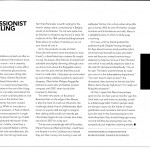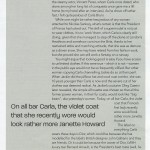Category Archives: Columns
A model wife – AUSTRALIAN FINANCIAL REVIEW
Holidaying with Ikea – AUSTRALIAN FINANCIAL REVIEW
That IKEA has caught on, to the tune of about $US23.5 billion in 2010, is in part directly due to my mother, who will always drive out of her way for napkins and a jar of herrings.
AFR | December 2011
by Marion Hume
I was really excited. I had travelled to the source – a bit like Burton and Speke and the source of the Nile, except for the details, such as Burton didn’t actually make it to Lake Victoria and I didn’t have a camel. No need for camels with such a massive parking lot. What lay before me was not nile green, but the world’s most recognized colour combination, yellow and blue. I had reached the birthplace of IKEA.
Actually, I’ve just lied a bit and I’m sad about that. Ingvar Kamprad opened the first IKEA in Smaland. But my Swedish friend insisted the Goteburg branch was better, so while I missed the thrill of the most ancient temple of flat-packing, a still historic source of self-assembly was good enough. I could barely contain my excitement as I grabbed my yellow ‘for use in store’ bag.
I should confess here that I love IKEA. I just do not understand why people hate it. I mean, even I can follow instructions and build a drawer. I also love that the designs are democratic, which is to say affordable and widely applicable. Not for you with your ‘shabby chic’ sitting room? But have you thought of how happily one of the $10 tables will sit next to your overstuffed armchair were you only to cover it in a pretty chintz cloth?
As for hiding in plain sight, one swanky decorator of my acquaintance stocks up on LACK bookshelves for oligarch clients’ homes. Sure, she puts the IKEA mostly in the chauffeurs and security guards’ accommodation, but she always sneaks a bit into the main house(s) because it fills the gaps. Then there’s the eco-thought, the sustainability, the effort that has gone in to flushing all those toilets with reclaimed grey water. I’m not crazy about the meatballs, but why linger in the canteen when there are wash bags to snap up, just like the ones at Prada but with more useful mesh pockets?
Still, I’ll concede that few people, when booking a holiday, want a Swedish farm house, by water, no internet access (on vacation from email) and an easy drive to IKEA. But then few can rival my connections to this mighty brand. Back in the 1950s, my parents, students at The Glasgow School of Art, both won travel scholarships to study Scandinavian design. Fueled by a shared love of skandichic, they returned to Sweden a second time just as an empire was dawning. I’ll say this for my canny Scots folks; while many others would have doubted anyone would pay to make their own furniture while there were craftsmen in every village, my Mum and Dad took one look at the LOVET table with removable legs (so it packed easily into the Volvo) and decided IKEA would could catch on. That it has, to the tune of about $US23.5 billion in 2010, is still, in part, directly due to my moth Perhaps it is because of this history that I am drawn to IKEA and indeed it
Perhaps it is because of this history that I am drawn to IKEA and indeed it is drawn to me. I once sat next to an IKEA kitchen designer on the plane to Shanghai; then I was on a little plane in Kenya and the woman next to me was part of an initiative to support women’s rights in communities. “Which NGO do you work for?” I asked. “IKEA,” she answered. But there’d be no need for an allen key in a manyatta mud hut.
Here’s what I observed in Gotenberg. In the kitchen sales area, there were people actually cooking. In the bed area, blondes of various sizes were testing a mattress via a family group hug. But most novel of all, people in workout gear were walking ‘the long natural way’ (the route designed to encourage the customer to see the store in its entirety) using those arctic ski poles. In an empire born in a cold country and on a bedrock of practical ideas, who could say they shouldn’t?
The Critical Choices – AUSTRALIAN FINANCIAL REVIEW
Cultivating concierges at the best hotels has its rewards when a crisis ensues.
The Critical Choices
AFR | 2011
by Marion Hume
There are various choices one must make in a crisis. For me, as the privileged holder of two passports, the first might be “what nationality am I today?”. I know this is a cliché but, were I in a situation which required guts and muscle (these possessed not by me of course, but instead by some taciturn yet decent bloke, possibly to be played in the true-life movie by Russell Crowe) then I’d be Australian. I suppose if the crisis required sneaky diplomacy issued with velvety vowels, I’d be British. After all, they do say the greatest skill of British diplomats is they can tell people to go to hell and make them believe they will enjoy the trip.
In a smaller crisis; which is to say one not involving fleeing to an embassy and being helicoptered off the roof, there are also choices to be made. Mine, if possible, is “head for nearest five-star hotel”. Now, to be clear, I do budget. I’m the expert in ‘charming’ hotels where I have to haul my suitcase up the 18th century stairs to the attic. But, when budget allows, I’m there at the desk making a friend of the five-star concierge with four crossed keys on his lapels.
The elite, global band of Les Clefs d’Or concierges was founded by the 11 concierges of the grand Paris hotels in 1929. Today, members must pass challenges far trickier than getting you a table at a restaurant or tickets to a show. A micro-crisis, such as volcano ash, brings Europe to a standstill? The concierge at the Gritti Palace, Venice, not only booked every minivan in northern Italy to transport guests home, he worked out who would get on with whom with the skill of a society hostess planning a gala, packed posh picnics and made those who had arrived via the splendour of the Orient Express believe three days in a van would be an awfully big adventure.
Suddenly stranded in Hong Kong? The concierge at Lanson Place (a surprisingly tranquil and intimate hotel despite being housed in a 26-storey skyscraper) won’t just tell you a morning walk will help you get things in perspective, he will literarily lead the way – the hotel offers ‘wow walks’ free of charge or tip, to help guests feel at home in the neighbourhood.
So when my flight home from Geneva was cancelled recently, the first thing I did was phone the concierge at the lovely Le Richemond. “We’re completely full but don’t worry,” Emanuel soothed. The queue to get any flight information was long, the atmosphere charged – not surprising given airspace was closed due to an electrical storm. At times like this the choice is to behave well or not. Showing how not to do it, the bloke with the Brietling watch flashed his frequentflier gold card, even though this was Geneva where everyone is wealthy and frequent fliers are thick on the ground.
When the woman in front of me finally reached the desk, she did the ‘sobbing act’, protesting she could not possibly fund another hotel night (for which she would be refunded) and where could she sleep at the airport, sob sob? The tantrum didn’t wash with me. This season’s Celine, Manolos and a Roger Vivier handbag, and you don’t have a credit card? OK, so I was surprised I couldn’t get on any flight for 24 hours, but just then Emanuel called, a reservation had been cancelled, I had a room as well as a dinner booking somewhere not expensive “because perhaps you had not budgeted for this evening?” And as to my surprise free day? Les Bains des Paquis, entrance fee €2, is at the end of a pier in the middle of Lake Leman. You can swim then enjoy a set lunch. That I got to dry off on plush mongrammed towels kindly lent by Le Richemond was a very nice touch.




